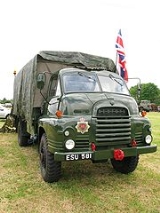
Bedford RL
Encyclopedia
The Bedford RL was the British Military's
main medium lorry (truck
), built by Bedford Vehicles
, from the mid 1950s until the late 1960s.
weight. The last RL rolled off the production line in the early 1970s, and all together a total of 74,000 being produced.
producing 110 bhp, although some were fitted with diesel engine
s.
 Many specialist variants were also built; including recovery vehicles, mobile workshops, radio vans and cable layers. The Green Goddess
Many specialist variants were also built; including recovery vehicles, mobile workshops, radio vans and cable layers. The Green Goddess
fire engine was also based on the RL.
The RL and variants continued to serve alongside the later Bedford MK and Bedford TM
trucks until well into the 1990s.
The Home Office
also purchased a large number of these vehicles, kept in reserve for any national emergency. All have now since been disposed of, many having less than 2000 mile on the clock.
British Armed Forces
The British Armed Forces are the armed forces of the United Kingdom of Great Britain and Northern Ireland.Also known as Her Majesty's Armed Forces and sometimes legally the Armed Forces of the Crown, the British Armed Forces encompasses three professional uniformed services, the Royal Navy, the...
main medium lorry (truck
Truck
A truck or lorry is a motor vehicle designed to transport cargo. Trucks vary greatly in size, power, and configuration, with the smallest being mechanically similar to an automobile...
), built by Bedford Vehicles
Bedford Vehicles
Bedford Vehicles, usually shortened to just Bedford, was a subsidiary of Vauxhall Motors, itself the British subsidiary of General Motors , established in 1930; and constructing commercial vehicles. Bedford Vehicles was a leading international truck manufacturer, with substantial export sales of...
, from the mid 1950s until the late 1960s.
History
The Bedford RL was based on on the Bedford SCL, a civilian 7-ton truck. The military version had all wheel drive and bigger wheels to increase ground clearance. Originally conservatively rated at 3 tons, all RL GS (general service) trucks in British Military service were, at a late stage in their service lives, re-rated at 4 tons without any mechanical modifications; the weight referring to its rated cross country payloadCargo
Cargo is goods or produce transported, generally for commercial gain, by ship, aircraft, train, van or truck. In modern times, containers are used in most intermodal long-haul cargo transport.-Marine:...
weight. The last RL rolled off the production line in the early 1970s, and all together a total of 74,000 being produced.
Design
The RL was powered by a 4.9 litres (298.8 cu in) petrol enginePetrol engine
A petrol engine is an internal combustion engine with spark-ignition, designed to run on petrol and similar volatile fuels....
producing 110 bhp, although some were fitted with diesel engine
Diesel engine
A diesel engine is an internal combustion engine that uses the heat of compression to initiate ignition to burn the fuel, which is injected into the combustion chamber...
s.
Variants

Green Goddess
The Green Goddess is the colloquial name for the Bedford RLHZ Self Propelled Pump, a fire engine used originally by the Auxiliary Fire Service , and latterly by the British Armed Forces. These green-painted vehicles were built between 1953 and 1956 for the Auxiliary Fire Service...
fire engine was also based on the RL.
The RL and variants continued to serve alongside the later Bedford MK and Bedford TM
Bedford TM
The Bedford TM was a heavy goods vehicle constructed by Bedford Vehicles, the British arm of General Motors' commercial vehicle division, between 1974 and 1986. Up until the TM, Bedford had been building mostly low-specification short haul distribution trucks, such as the Bedford TK and KM...
trucks until well into the 1990s.
The Home Office
Home Office
The Home Office is the United Kingdom government department responsible for immigration control, security, and order. As such it is responsible for the police, UK Border Agency, and the Security Service . It is also in charge of government policy on security-related issues such as drugs,...
also purchased a large number of these vehicles, kept in reserve for any national emergency. All have now since been disposed of, many having less than 2000 mile on the clock.

